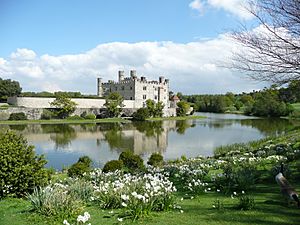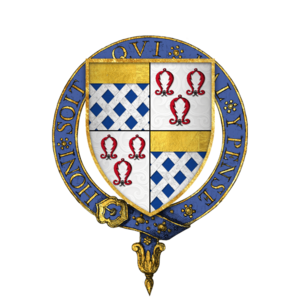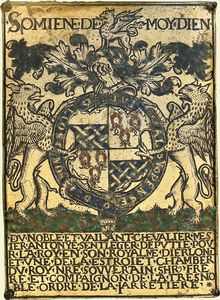Anthony St Leger (Lord Deputy of Ireland) facts for kids
Sir Anthony St Leger (around 1496 – 16 March 1559) was an important English politician. He lived in Kent, England, and served as the Lord Deputy of Ireland during the time of the Tudor kings and queens. This means he was like the King's main representative or governor in Ireland.
Contents
Early Life and Career
Anthony St Leger was born into a noble family in Kent. His father was Ralph St Leger, and his mother was Isabel Haute. He studied abroad and at the University of Cambridge. He quickly became a favorite of King Henry VIII.
In 1537, King Henry VIII sent him to Ireland to study the country's situation. This trip helped him learn a lot about Ireland. By 1539, he was made a knight and became the High Sheriff of Kent, which was a high-ranking local official.
Lord Deputy of Ireland
On 7 July 1540, Sir Anthony was given a very important job: he was made the Lord Deputy of Ireland. His main task was to bring order to the country.
He worked to make peace with powerful Irish families. For example, he allowed the MacMorrough-Kavanagh clan to keep their lands if they agreed to follow English rules. He did similar things with other groups like the O'Mores and O'Conors.
Sir Anthony also convinced the Irish Parliament in Dublin to pass a law. This law made King Henry VIII the official King of Ireland. Before this, the English king was only "Lord of Ireland." This was a big change! He also convinced Conn O'Neill, a powerful Irish leader, to accept English rule. This policy was called "Surrender and regrant." It meant Irish lords would give up their lands to the King and then get them back under English law, often with new titles.
Sir Anthony believed in being fair and trying to make agreements, even more than King Henry VIII sometimes wanted. He suggested giving Irish leaders new noble titles, like making the head of the O'Brien family the Earl of Thomond, and O'Neill the Earl of Tyrone. He thought that giving "small gifts and honest persuasion" worked better than being harsh. This approach helped many Irish families, like the Plunketts and Fitzpatricks, become loyal to the English Crown. For example, Barnaby Fitzpatrick, 2nd Baron Upper Ossory grew up with King Henry VIII's son, Edward VI, and they were good friends.
In 1544, Irish soldiers were even raised to help King Henry VIII in his wars. When Sir Anthony left Ireland for a visit to England in 1544, there were some problems, but things quickly became peaceful again when he returned.
He continued as Lord Deputy under King Edward VI. He helped stop new rebellions. From 1548 to 1550, he was in England. When he came back to Ireland, he was asked to introduce new religious practices. However, his gentle approach led to him being called back to England in 1551.
After Queen Mary became queen in 1553, he was again appointed Lord Deputy. But in 1556, he was called back a third time because of a problem with his accounts. He died in 1559 while this was still being looked into. He had also been elected as a Member of Parliament for Kent that year.
Knight of the Garter
In 1544, King Henry VIII chose Sir Anthony to be a Knight of the Garter. This is a very special and old honor in England. His special plate, called a Garter stall plate, is still in St George's Chapel, Windsor Castle. It has a motto that seems to mean "I remember my God."
The plate also describes him as a "noble and valiant knight" and "deputy for the king in his kingdom of Ireland." It shows his family's coat of arms, which is like a family symbol.
Personality
Sir Anthony sometimes had disagreements with other important people in Ireland. He didn't always get along with John Alan, who was the Lord Chancellor of Ireland, or George Browne, the Archbishop of Dublin. There were some disagreements and accusations against him, but they didn't lead to anything.
Land and Property

Sir Anthony inherited his family's home in Ulcombe, which had been their seat since the 11th century. In 1552, he was also given Leeds Castle in Kent. His grandfather had once been in charge of this castle.
Family Life
Sir Anthony St Leger married Agnes Warham. She was the daughter of Sir Hugh Warham and the niece of William Warham, who was the Archbishop of Canterbury.
Sir Anthony and Agnes had at least five sons and two daughters. One of their sons, William St Leger, passed away before his father. However, William had a son named Sir Warham St Leger (who died in 1600). Sir Warham's own son was also named William St Leger (who died in 1642) and became the President of Munster.
See Also
- Surrender and regrant



